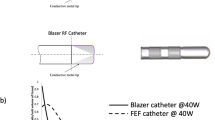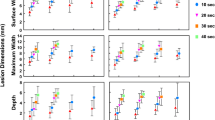Abstract
Background: A variety of basic factors such as electrode tip pressure, flow around the electrode and electrode orientation influence lesion size during radiofrequency ablation, but importantly is dependent on the chosen mode of ablation. However, only little information is available for the frequently used temperature-controlled mode. The purpose of the present experimental study was to evaluate the impact during temperature-controlled radiofrequency ablation of three basic factors regarding electrode-tissue contact and convective cooling on lesion size.
Methods and Results: In vitro strips of porcine left ventricular myocardium were ablated in a tissue bath. Temperature-controlled ablation at 80 °C for 60 s was performed using a 7F 4 mm tip electrode in either perpendicular or parallel contact with the endocardium at a pressure of 10 or 20 g. Increased flow around the electrode was induced by circulating the saline in the tissue bath at a flow-velocity of 0.1 m/s. Lesion volume was determined by cutting lesions in 1 mm thick slices, staining with nitroblue tetrazolium and planimetering. A total of 107 lesions was created. Lesion size was significantly larger for perpendicular electrode orientation compared to parallel for both pressure-settings and both levels of flow around the electrode (p < 0.05). Increased flow around the electrode enlarged lesion size (p < 0.005). Electrode-tissue contact pressure had no significant impact on lesion size.
Conclusions: During temperature-controlled radiofrequency ablation increased external cooling of the electrode tip due to either flow of the surrounding liquid or poor electrode tissue contact, as exemplified by perpendicular versus parallel electrode orientation, increases lesion size significantly. This is in contrast to the impact of these factors during power-controlled ablation due to the lack of increased power-delivery in the latter situation.
Similar content being viewed by others
References
Petersen HH, Chen X, Pietersen A, et al. Lesion dimensions during temperature-controlled radiofrequency ablation of left ventricular porcine myocardium: ablation site and electrode size related to convective cooling. Circulation 1999;99:319–325.
Nakagawa H, Wittkampf FH, Yamanashi WS, et al. Inverse relationship between electrode size and lesion size during radiofrequency ablation with active cooling. Circulation 1998;98:458–465.
Hoyt RH, Huang SKS, Marcus FI, et al. Factors influencing trans-catheter radiofrequency ablation of the myocardium. J Appl Cardiol 1986;1:469–486.
Ring ME, Huang SKS, Gorman G, et al. Determinants of impedance rise during catheter ablation of bovine myocardium with radiofrequency energy. Pacing Clin Electrophysiol 1989;12:1502–1513.
Avitall B, Mughal K, Hare J, et al. The effects of electrodetissue contact on radiofrequency lesion generation. Pacing Clin Electrophysiol 1997;20:2899–2910.
Kongsgaard E, Steen T, Jensen O, et al. Temperature guided radiofrequency catheter ablation of myocardium: Comparison of catheter tip and tissue temperatures in vitro. Pacing Clin Electrophysiol 1997;20(1):1252–1260.
Nakagawa H. Yamanashi WS, Pitha JV, et al. Comparison of in vivo tissue temperature profile and lesion geometry for radiofrequency ablation with a saline-irrigated electrode versus temperature control in a canine thigh muscle preparation. Circulation 1995;91(8):2264–2273.
Otomo K, Yamanashi WS, Tondo C, et al. Why a large tip electrode makes a deeper radiofrequency lesion: Effects of increase in electrode cooling and electrode-tissue interface area. J Cardiovasc Electrophysiol 1998;9:47–54.
Haines DE. Determinants of lesion size during radiofrequency catheter ablaiton: The role of electrode-tissue contact pressure and duration of energy delivery. J Cardiovasc Electrophysiol 1991;2:509–515.
Ruffy R, Imran MA, Santel DJ, et al. Radiofrequency delivery through a cooled catheter tip allows the creation of larger endomyocardial lesions in the ovine heart. J Cardiovasc Electrophysiol 1995;6:1089–1096.
Mittleman RS, Huang SKS, de Guzman WT, et al. Use of the saline infusion electrode catheter for improved energy delivery and increased lesion size in radiofrequency catheter ablation. Pacing Clin Electrophysiol 1995;18(1):1022–1027.
Petersen HH, Chen X, Pietersen A, et al. Temperature-controlled irrigated tip radiofrequency catheter ablation: Comparison of in vivo and in vitro lesion dimensions for standard catheter and irrigated tip catheter with minimal infusion rate. J Cardiovasc Electrophysiol 1998;9:409–414.
Anfinsen OG, Kongsgaard E, Aass H, et al. Radiofrequency catheter ablation in vitro: The difference between tissue and catheter tip temperature depends on location of the temperature sensor. Eur J C P E 1996;6:195–203.
Author information
Authors and Affiliations
Rights and permissions
About this article
Cite this article
Petersen, H.H., Chen, X., Pietersen, A. et al. Temperature-controlled Radiofrequency Ablation of Cardiac Tissue: An In Vitro Study of the Impact of Electrode Orientation, Electrode Tissue Contact Pressure and External Convective Cooling. J Interv Card Electrophysiol 3, 257–262 (1999). https://doi.org/10.1023/A:1009864111507
Issue Date:
DOI: https://doi.org/10.1023/A:1009864111507




